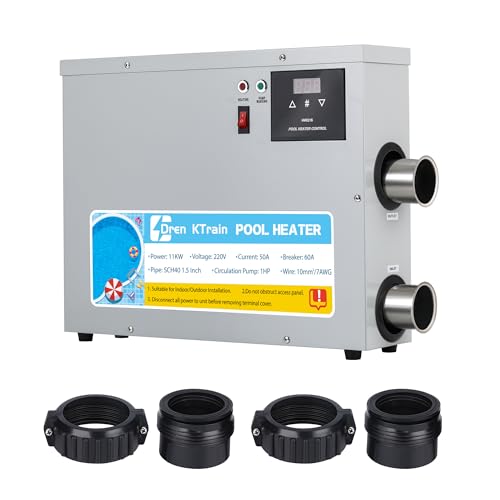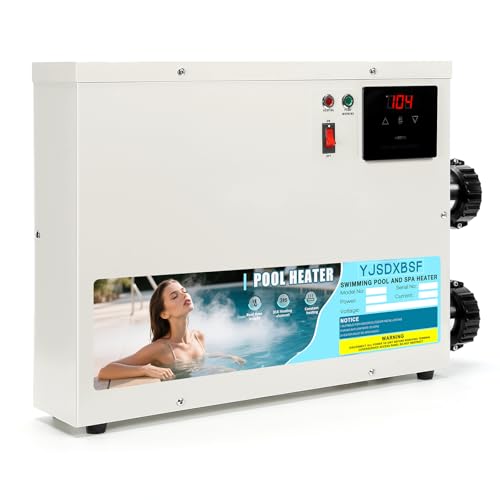Choosing the right heater for an in-ground hot tub affects comfort, operating cost, and longevity. This guide reviews five in-ground compatible heaters and heater components across gas, electric, and replacement assembly options. The short summary table below helps compare core specs at a glance.
| Product | Type | Key Feature |
|---|---|---|
| Hayward W3H150FDN Universal H-Series | Natural Gas | 150,000 BTU, cupro-nickel heat exchanger |
| Mxmoonant Pool Heater 11KW | Electric | 11KW, touchscreen, 304 stainless tubing |
| Pool Heater 11KW (Dren KTrain) | Electric | 11KW, touchscreen, automatic cycling |
| Pool Heater 9KW (YJSDXBSF) | Electric | 9KW, thermostat controls, safety cutoffs |
| FATCANMA Spa Hot Tub Heater Assembly | Replacement Assembly | Flow-thru heater housing, compatible with Sundance |
Content Navigation
Hayward W3H150FDN Universal H-Series 150,000 BTU

Type: Natural Gas Pool & Spa Heater. Key Features: Designed for in-ground pools and spas, this unit delivers 150,000 BTU and includes a cupro nickel heat exchanger intended to resist corrosion from unbalanced water chemistry. The product listing highlights an industry-leading hydraulic design that reduces circulation pump run time to save energy.
This model is tailored to higher-demand installations where fast recovery and steady output matter. The cupro-nickel exchanger is notable for durability in harsh water conditions. Ideal for users prioritizing continuous heat output and long-term resistance to corrosion in in-ground hot tubs connected to natural gas.
Mxmoonant Pool Heater 11KW 220V Electric

Type: Electric Inline Heater. Key Features: 11KW output at 220V, an upgraded touchscreen display for precise temperature control, automatic circulating heating that cycles based on preset temperature, and 304 stainless steel heating tubes for efficient heat transfer.
Call 888-896-7031 for Free Local HVAC Quotes – Compare and Save Today!
The 11KW rating targets medium to larger hot tubs and in-ground pools with compatible electrical service. The touchscreen simplifies setpoint adjustments while the automatic cycling maintains a chosen temperature without continuous manual intervention. Use cases include retrofit installations where an electric hardwired heater is preferred and 304 stainless steel offers solid corrosion resistance under standard water chemistries.
Pool Heater 11KW 220V (Dren KTrain)

Type: Electric Thermostatic Heater. Key Features: 11KW electric heating with touchscreen control, automatic circulating heating that cycles on/off by preset temperature, and a display range supporting wide temperature settings. The unit emphasizes ease of operation and seasonal extension capabilities for pools and spas.
As an electric in-line heater, it suits installations with available 220V service and appropriate breaker capacity. The product is positioned for users who want precise temperature feedback and an easy-to-read touch interface. The automatic mode reduces manual oversight by restarting only when temperature drops below the setpoint.
Pool Heater 9KW 220V Electric Thermostat

Type: Electric Inline Heater. Key Features: 9KW output designed for pools approximately 800 gallons, built-in thermostat control, automatic on/off operation and high temperature protection switch to cut power if water flow is insufficient or inlet is clogged.
Call 888-896-7031 for Free Local HVAC Quotes – Compare and Save Today!
This heater is intended for smaller in-ground or above-ground hot tubs where the 9KW capacity matches volume and recovery expectations. The safety cutoffs for high temperature and low flow are important for protecting the heating element and minimizing hazard in restricted plumbing setups. Installation requires correct plumbing and proper electrical circuit rating.
FATCANMA Spa Hot Tub Heater Assembly With 4.0KW Element

Type: Replacement Flow-Thru Heater Assembly. Key Features: Designed compatibility with Jacuzzi, Sundance, and other spa controls, dimensions 2in x 15in stainless steel manifold, split nut unions of 2in, and materials rated for humid environments.
This assembly targets repair and OEM-replacement scenarios where the original flow-thru heater housing or element has failed. It suits hot tubs using the specified housing dimensions and offers an option to restore factory-style flow-thru heating. Check compatibility with your spa model before purchase and confirm plumbing union diameters and electrical element specifications match your system.
Buying Guide: Choosing An In-Ground Hot Tub Heater
Selecting the best heater requires matching heater type, capacity, plumbing, electrical service, and maintenance expectations to your hot tub. Key considerations are outlined below.
Heater Type: Gas vs Electric vs Replacement Assembly
- Natural Gas/Propane: High BTU output and fast recovery. Well-suited for larger in-ground hot tubs or installations needing rapid temperature recovery after heavy use. Requires gas supply and compliant ventilation and gas lines.
- Electric Inline Heaters: Easier to install where sufficient 220V/240V electrical service exists. Lower upfront installation complexity compared with gas but may have higher operating cost for large tubs unless sized correctly.
- Replacement Assemblies: Useful for restoring existing systems. Ensure exact compatibility with housing dimensions, unions, and element wattage before ordering.
Capacity And Recovery Rate
- Match KW/BTU To Water Volume: Larger tubs need higher KW or BTU to heat within a reasonable time. For example, 9–11KW units suit small-to-medium hot tubs; 150,000 BTU gas units serve large in-ground installations.
- Recovery Time: Consider how quickly you want to regain temperature after adding fresh water or heavy use. Faster recovery typically requires greater power and may increase energy or fuel consumption.
Plumbing And Flow Requirements
- Minimum Flow Rates: Many inline heaters require a minimum pump flow. Using the wrong pipe size or low-flow pumps can cause overheating or trips. Follow manufacturer recommendations for pipe diameter and pump sizing.
- Fittings And Unions: Replacement housings must match union diameters (e.g., 1.5″, 2″) and physical dimensions to ensure leak-free installation.
Materials And Corrosion Resistance
- Heat Exchanger Material: Cupro-nickel and stainless steels (304/316) are common. Cupro-nickel offers strong corrosion resistance in varied water chemistries; 316 stainless provides higher resistance to chlorinated or salt environments.
- Durability: Choose materials matched to your water treatment (chlorine, bromine, salt systems) to avoid premature failure.
Controls, Safety, And Ease Of Use
- Thermostat & Display: Digital touchscreens provide precise control and easier monitoring. Look for Fahrenheit/Celsius options if needed.
- Safety Cutoffs: High-temperature protection, low-flow shutdown, and ground-fault protection (GFCI) are essential for safe operation.
- Automatic Cycling: Heaters that automatically cycle based on preset temps reduce manual adjustments and often save energy by minimizing on-time.
Installation And Electrical/Gas Requirements
- Electrical Service: Confirm that your property provides the necessary voltage and breaker capacity (e.g., 220V/240V at 9–11KW requires appropriately sized breakers and wiring).
- Gas Supply: Gas heaters need proper piping, ventilation, and local-code compliant installation by a licensed technician.
- Professional Installation: Many manufacturers require certified installation for warranty validity and safe operation; consult a licensed contractor when in doubt.
Maintenance And Water Chemistry
- Maintain Balanced Water: pH, alkalinity, and sanitizer levels affect corrosion and scaling. Proper chemistry extends heater life.
- Regular Inspections: Check for leaks, signs of corrosion, and ensure unions/fittings remain tight. Periodically inspect heating elements and heat exchangers per manufacturer guidance.
Comparison Perspectives
- Performance vs Cost: Gas heaters deliver faster recovery for large volumes but often carry higher installation complexity and fuel cost. Electric units are simpler to wire in but should be sized to avoid long run times.
- Durability vs Water Chemistry Needs: Cupro-nickel exchangers handle harsher water better; 316 stainless excels in salt-chlorinated applications. Replacement assemblies can restore OEM fit but require careful matching.
- Safety vs Convenience: Immersion-style or portable heaters offer convenience but are typically not intended for permanent in-ground installations. Inline hardwired options with safety cutoffs are preferable for built-in hot tubs.
Use the above considerations to prioritize features that match your hot tub size, water treatment approach, installation constraints, and maintenance preferences. Confirm compatibility with your unit and local codes before purchase and installation.
Tips for Getting the Best HVAC Prices
- Prioritize Quality Over Cost
The most critical factor in any HVAC project is the quality of the installation. Don’t compromise on contractor expertise just to save money. - Check for Rebates
Always research current rebates and incentives — they can significantly reduce your overall cost. - Compare Multiple Quotes
Request at least three estimates before making your choice. You can click here to get three free quotes from local professionals. These quotes include available rebates and tax credits and automatically exclude unqualified contractors. - Negotiate Smartly
Once you've chosen a contractor, use the proven strategies from our guide — How Homeowners Can Negotiate with HVAC Dealers — to get the best possible final price.
